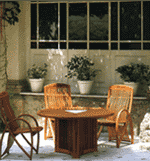|
|
 |
 |
 |
 |
 |
| |
 |
 |
Crafts
- or handicrafts - vary enormously in shape, material and use,
and nowhere are these variations more apparent than Indonesia.
The 17,000 islands of the Indonesian archipelago are home to
perhaps the world's richest diversity of cultures, languages
and traditions, and the fertile tropical land has always supplied
abundant natural wealth to its inhabitants. Many of the 350
or so ethnic groups have grown up in relative isolation from
one another, separated by coral seas and brooding volcanic mountain
ranges. This isolation has given rise to rich, varied seams
of cultural tradition and a resultant plethora of highly indivuidualised
arts and crafts.
The common thread running through all these crafts is the skill
involved in turning raw material into an object of utility and
charm, the link between mind and nature made by the perfect
co-ordination of hand and eye. Crafts are the humanization of
a small part of nature, shaped by hands deeply knowledgeable
in the properties of the material and the processes that transform
it. This skill is the accumulation of generations of experience,
trial and error, discovery and adaptation. What may have originally
been made as a functional tool, created to serve some domestic
or agricultural purpose, becomes perfected and elaborated into
an art form. Undivided creative energy is channeled into the
fabrication process, and beauty begins to assume as much significance
as the original function. The finest examples of these art forms
are often elevated to a spiritual plane, acting as vital accessories
in sacred ceremonies and rituals; the utilitarian aspect disappears,
and the craft becomes a symbolic icon. There is something quintessentially
human in the necessity to rise above the functional plain of
existence, and this is what crafts represent: the beautification
of our means of existence by hands tempered by generations of
experience.
From the Stone Age totems of Irian Jaya and the outer islands,
to elaborate batiks and intricate filigree silverwork of regal
Bali and Java, through to the glitzy shopping plazas of Jakarta,
Indonesia traces a history of artistic creativity and trade.
The archipelago's natural and cultural riches have been bought
and sold along the Silk Road from China to Arabia for centuries,
each nation leaving their own mark. Merchants from India introduced
Hindu and Buddhism, influencing the elaborate courtly life of
the Majapahit and Srivijaya empires of the 13th and 14th centuries.
Crafts and designs that evolved to ply these ancient kingdoms
still flourish in Java and Bali today. 13th century Arab traders
brought Islam and associated influences. The ceremonial dress
of imperial China fed elaborate silks and designs into Indonesian
textiles, while oriental porcelains gave rise to the deep, rich
lacquer work now found in southern Sumatra. European traders,
and particularly the Portuguese and Dutch colonials, stimulated
the growth of wood and iron furniture traditions, while early
20th century European settlers had a significant influence on
Fine Art traditions.
In an otherwise industrialised world, we are inevitably moved
when we sense the perfect co-ordination between the innate qualities
of a natural material and the skilled human hands that shape
it. When function harmonises perfectly with colours and patterns,
when beauty has been given as much emphasis as purpose, when
natural material has been shaped with a na´ve honesty or breathtaking
sophistication, we perceive something warmingly genuine and
reassuringly original. Evocative of tropical paradise islands
and exotic, spiritual eastern kingdoms, or rough carved from
deep jungle rock, wood, horn and bone, Indonesia's traditional
crafts offer a fascinatingly beautiful world to explore. |
|
 |
|
 |








